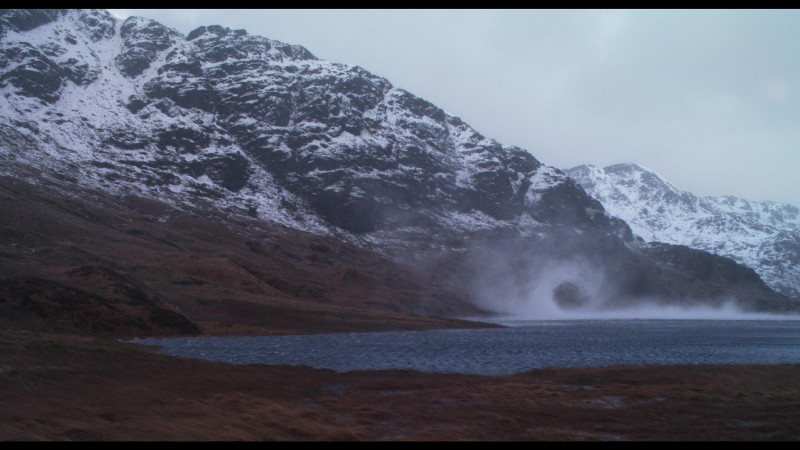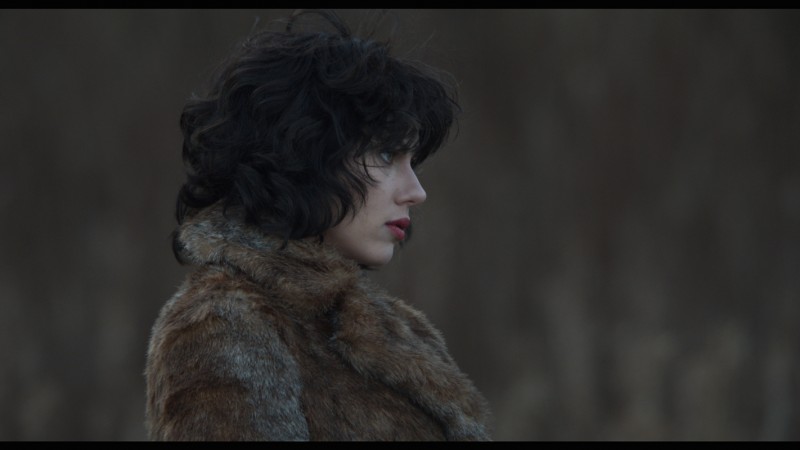Under the Skin: A Visual Feast
Under the Skin is the latest artistic venture by Jonathan Glazer that grips its audience with a coldly-deliberate style and wholly unique feel.
The film begins with a haunting series of celestial bodies haloed by light interacting with one another while a recording of a woman reciting phonetic sounds plays in the background. Cutting to a mysterious figure on a motorcycle, then to an all white room inhabited by two dark figures, Glazer is able to invoke the likes of Stanley Kubrick and Andrei Tarkovsky with hints of David Lynch-esque surrealism. The threadbare story focuses on a mysterious woman (Scarlett Johansson) who prowls the streets of Scotland in order to seduce men. Presented as an unflinchingly cold figure, the woman seems to be devoid of all emotion, and has no sense of empathy. Solely occupied with her seduction, the woman seems to study humanity at a distance while always remaining behind the wheel of her large van. The interactions that take place between the woman and any number of men seem incredibly genuine, and have a very voyeuristic quality. Capturing the subtleties and nuances of conversations between potential mates, Glazer does an impeccable job at conveying the uncomfortable nature of the situations. Playing like a documentary in a world of augmented reality,
Under the Skin comes off as considerably sincere and starkly honest.

Johansson does an admirable job in her role as the mysterious woman. Appearing as completely lifeless when alone in her van, and strangely friendly when approaching strangers; she gives depth to a mostly-quiet character. Using sharp glances and studying looks, she explores her surroundings like a foreigner abroad, pensively absorbing her environment and the people which occupy it. As the film progresses, her character becomes more focused on her own humanity, and what it means to be human. Shifting her gaze inward, Johansson explores her characters inner conflict without uttering a word of dialogue. Witnessing the full breadth of humanity along her journey of self-exploration, Johansson's character is privy to the height of selfless acts of heroism, and the lowest depths of depravity.

Glazer's artfully adept direction is the shining beacon of this film. Filling each frame with menacing shadows or breathtaking landscapes, Glazer paints a beautiful picture. Cinematographer, Daniel Landin does a wonderful job at capturing the film's solemnly intense mood and fulfilling the director's vision. Shot as if by hidden camera, many of the scenes where Johansson's character aimlessly drives around the Glasgow city center, capture the various forms of human interaction. From isolation in very public settings to groups of teens and partygoers on the outskirts of town, Glazer finds artistic merit in all people. Cooperating nicely with his film's poetic visuals, the Scottish countryside is absolutely mesmerizing. With locations ranging from the awe-inspiring seaside, to the snow and tree covered highlands, Glazer beautifully captures the emptiness and isolation of the Scottish landscape. With these beautiful landscapes juxtaposed alongside the bustling streets of equal isolation, Glazer fills
Under the Skin with thought provoking visual metaphor. Hardly a film that is easily followed or understood, the visual feast with which Glazer presents his audience is more than enough to keep his viewers engrained in the film.

While
Under the Skin is certainly not for all types of audiences, lovers of cinematography and challenging themes will be absolutely enthralled. Certainly a film that is meant to be enjoyed over several viewings,
Under the Skin is a thought-provoking cinematic joy.
Pros
- Coldly Menacing performance by Johansson
- Beautiful Cinematography
- Surprisingly Enthralling
Cons
- Ambiguity may turn some viewers off
 Johansson does an admirable job in her role as the mysterious woman. Appearing as completely lifeless when alone in her van, and strangely friendly when approaching strangers; she gives depth to a mostly-quiet character. Using sharp glances and studying looks, she explores her surroundings like a foreigner abroad, pensively absorbing her environment and the people which occupy it. As the film progresses, her character becomes more focused on her own humanity, and what it means to be human. Shifting her gaze inward, Johansson explores her characters inner conflict without uttering a word of dialogue. Witnessing the full breadth of humanity along her journey of self-exploration, Johansson's character is privy to the height of selfless acts of heroism, and the lowest depths of depravity.
Johansson does an admirable job in her role as the mysterious woman. Appearing as completely lifeless when alone in her van, and strangely friendly when approaching strangers; she gives depth to a mostly-quiet character. Using sharp glances and studying looks, she explores her surroundings like a foreigner abroad, pensively absorbing her environment and the people which occupy it. As the film progresses, her character becomes more focused on her own humanity, and what it means to be human. Shifting her gaze inward, Johansson explores her characters inner conflict without uttering a word of dialogue. Witnessing the full breadth of humanity along her journey of self-exploration, Johansson's character is privy to the height of selfless acts of heroism, and the lowest depths of depravity.
 Glazer's artfully adept direction is the shining beacon of this film. Filling each frame with menacing shadows or breathtaking landscapes, Glazer paints a beautiful picture. Cinematographer, Daniel Landin does a wonderful job at capturing the film's solemnly intense mood and fulfilling the director's vision. Shot as if by hidden camera, many of the scenes where Johansson's character aimlessly drives around the Glasgow city center, capture the various forms of human interaction. From isolation in very public settings to groups of teens and partygoers on the outskirts of town, Glazer finds artistic merit in all people. Cooperating nicely with his film's poetic visuals, the Scottish countryside is absolutely mesmerizing. With locations ranging from the awe-inspiring seaside, to the snow and tree covered highlands, Glazer beautifully captures the emptiness and isolation of the Scottish landscape. With these beautiful landscapes juxtaposed alongside the bustling streets of equal isolation, Glazer fills Under the Skin with thought provoking visual metaphor. Hardly a film that is easily followed or understood, the visual feast with which Glazer presents his audience is more than enough to keep his viewers engrained in the film.
Glazer's artfully adept direction is the shining beacon of this film. Filling each frame with menacing shadows or breathtaking landscapes, Glazer paints a beautiful picture. Cinematographer, Daniel Landin does a wonderful job at capturing the film's solemnly intense mood and fulfilling the director's vision. Shot as if by hidden camera, many of the scenes where Johansson's character aimlessly drives around the Glasgow city center, capture the various forms of human interaction. From isolation in very public settings to groups of teens and partygoers on the outskirts of town, Glazer finds artistic merit in all people. Cooperating nicely with his film's poetic visuals, the Scottish countryside is absolutely mesmerizing. With locations ranging from the awe-inspiring seaside, to the snow and tree covered highlands, Glazer beautifully captures the emptiness and isolation of the Scottish landscape. With these beautiful landscapes juxtaposed alongside the bustling streets of equal isolation, Glazer fills Under the Skin with thought provoking visual metaphor. Hardly a film that is easily followed or understood, the visual feast with which Glazer presents his audience is more than enough to keep his viewers engrained in the film.
 While Under the Skin is certainly not for all types of audiences, lovers of cinematography and challenging themes will be absolutely enthralled. Certainly a film that is meant to be enjoyed over several viewings, Under the Skin is a thought-provoking cinematic joy.
While Under the Skin is certainly not for all types of audiences, lovers of cinematography and challenging themes will be absolutely enthralled. Certainly a film that is meant to be enjoyed over several viewings, Under the Skin is a thought-provoking cinematic joy.